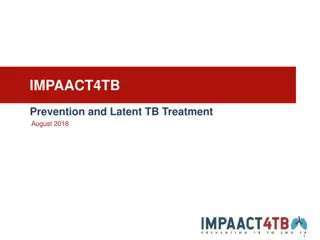Understanding Latent Class Analysis in Research
Latent Class Analysis (LCA) is a person-centered approach that categorizes individuals based on underlying differences. This method links observed behaviors to categorical variations, providing insights into groupings within data sets.
Download Presentation

Please find below an Image/Link to download the presentation.
The content on the website is provided AS IS for your information and personal use only. It may not be sold, licensed, or shared on other websites without obtaining consent from the author. Download presentation by click this link. If you encounter any issues during the download, it is possible that the publisher has removed the file from their server.
E N D
Presentation Transcript
Introduction to Latent Class Analysis Part II Dr Oliver Perra o.perra@qub.ac.uk
Summary: Latent Class Analysis (LCA) Person centred-approach A mixture of individuals assigned to different categories (classes) Measurement model: Observed behaviours are causally related to underlying categorical differences
Latent Class Analysis (LCA): Formal definitions A A = Low Mood a can be: 1 (Never) ; 2 (Sometimes); 3 (Most of the time). B B = Lack of Pleasure b can be: 1 (Never) ; 2 (Sometimes); 3 (Most of the time). C C = Sleep Problems c can be: 1 (Never) ; 2 (Sometimes); 3 (Most of the time). D D = Fatigue; d can be: 1 (Never) ; 2 (Sometimes); 3 (Most of the time). x can be: 1 or 2. X X = Latent class
Latent Class Analysis (LCA): Formal definitions A A = Low Mood acan be: 1 (Never) ; 2 (Sometimes); 3 (Most of the time). B B = Lack of Pleasure b can be: 1 (Never) ; 2 (Sometimes); 3 (Most of the time). C C = Sleep Problems c can be: 1 (Never) ; 2 (Sometimes); 3 (Most of the time). D D = Fatigue; d can be: 1 (Never) ; 2 (Sometimes); 3 (Most of the time). x can be 1 or 2. X X = Latent class ??????=?? ??|? ??|? ??|???|?
Latent Class Analysis (LCA): Formal definitions A A = Low Mood acan be: 1 (Never) ; 2 (Sometimes); 3 (Most of the time). B B = Lack of Pleasure b can be: 1 (Never) ; 2 (Sometimes); 3 (Most of the time). C C = Sleep Problems c can be: 1 (Never) ; 2 (Sometimes); 3 (Most of the time). D D = Fatigue; d can be: 1 (Never) ; 2 (Sometimes); 3 (Most of the time). x can be 1 or 2. X X = Latent class ??????=?? ??|? ??|? ??|???|? ??= 1.0 ??|?= ??|?= ??|?= ??|?= 1.0
Latent Class Analysis (LCA): Formal definitions A A = Low Mood acan be: 1 (Never) ; 2 (Sometimes); 3 (Most of the time). B B = Lack of Pleasure b can be: 1 (Never) ; 2 (Sometimes); 3 (Most of the time). C C = Sleep Problems c can be: 1 (Never) ; 2 (Sometimes); 3 (Most of the time). D D = Fatigue; d can be: 1 (Never) ; 2 (Sometimes); 3 (Most of the time). x can be 1 or 2. X X = Latent class ??????=?? ??|? ??|? ??|???|? ??=3; ?=3; ?=3; ?=3; ?=1=? ?=1 ??=3|?=1 ??=3|?=1 ??=3|?=1??=3|?=1
Example of Data ID Low Mood Lack Pleasure Sleep Problems Fatigue 101 1 1 2 1 102 3 3 2 3 103 1 2 1 1 104 2 1 3 2
Latent Class Analysis (LCA) Parameters A A = Low Mood acan be: B B = Lack of Pleasure b can be: 1 to 3. C C = Sleep Problems c can be: 1 to 3. D D = Fatigue d can be: 1 to 3. X X = Latent class x can be: 1 or 2. 1 (Never) ; 2 (Sometimes); 3 (Most of the time). Class membership probability ??=1 and??=2 with constraint: ??=1 +??=2 = 1.0 ??????=?? ??|? ??|? ??|???|? ??= ??|?= ??|?= ??|?= ??|?= 1.0
Example of Data & Output ID Low Mood Lack Pleasure Sleep Problems Fatigue Class membership probability ??=1 and ??=2 ??= 1.0 ??=1 +??=2 = 1.0 101 1 1 2 1 102 3 3 2 3 103 1 2 1 1 104 2 1 3 2 Latent class 0.1254 C1 or else: ??=1 C2 or else: ??=2 0.8846
Latent Class Analysis (LCA) Parameters Class membership probability Conditional item response probabilities ??=1|?=1 ; ??=2|?=1; ??=3|?=1 ; ??=1|?=2 ; ??=2|?=2; ??=3|?=2 ??=1|?=1+ ??=2|?=1+ ??=3|?=1 = 1 ??=1|?=2+ ??=2|?=2+ ??=3|?=2 = 1
Example of Data & Output ID Low Mood Lack Pleasure Sleep Problems Fatigue Latent class 0.1254 C1 or else: ??=1 101 1 1 2 1 0.8846 C2 or else: ??=2 102 3 3 2 3 Indicators Class 1 Class 2 103 1 2 1 1 Low Mood 1 (Never) 0.0235 0.8463 104 2 1 3 2 2 (Sometimes) 0.1838 0.1309 3 (Most times) 0.7927 0.0228 Lack Pleasure 1 (Never) 0.0173 0.9097 2 (Sometimes 0.2183 0.0881 ??=1|?=1 3 (Most times) 0.7644 0.0022
Example of Data & Output ID Low Mood Lack Pleasure Sleep Problems Fatigue Latent class ? 0.1254 C1 or else: ??=1 C2 or else: ??=2 101 1 1 2 1 ? 0.8846 102 3 3 2 3 Indicators Class 1 Class 2 103 1 2 1 1 Low Mood 1 (Never) 0.0235 0.8463 104 2 1 3 2 2 (Sometimes) 0.1838 0.1309 3 (Most times) 0.7927 0.0228 Lack Pleasure 1 (Never) 0.0173 0.9097 ??=1|?=1 2 (Sometimes 0.2183 0.0881 3 (Most times) 0.7644 0.0022 ??=2|?=1 ??=3|?=1
Example of Data & Output ID Low Mood Lack Pleasure Sleep Problems Fatigue Latent class ? 0.1254 C1 or else: ??=1 C2 or else: ??=2 101 1 1 2 1 ? 0.8846 102 3 3 2 3 Indicators Class 1 Class 2 103 1 2 1 1 Low Mood 1 (Never) 0.0235 0.8463 104 2 1 3 2 2 (Sometimes) 0.1838 0.1309 3 (Most times) 0.7927 0.0228 Lack Pleasure 1 (Never) 0.0173 0.9097 ??=1|?=1 2 (Sometimes 0.2183 0.0881 3 (Most times) 0.7644 0.0022 ??=2|?=1 ??=1|?=1 + ??=2|?=1 + ??=3|?=1 = 1.0 ??=3|?=1
Example of Data & Output ID Low Mood Lack Pleasure Sleep Problems Fatigue Latent class ? 0.1254 C1 or else: ??=1 C2 or else: ??=2 101 1 1 2 1 ? 0.8846 102 3 3 2 3 Indicators Class 1 Class 2 103 1 2 1 1 Low Mood 1 (Never) 0.0235 0.8463 104 2 1 3 2 2 (Sometimes) 0.1838 0.1309 3 (Most times) 0.7927 0.0228 Lack Pleasure 1 (Never) 0.0173 0.9097 2 (Sometimes 0.2183 0.0881 3 (Most times) 0.7644 0.0022
Visualising Conditional Probabilities Indicators Class 1 Class 2 Low Mood 1 (Never) 0.0235 0.8463 Probability of answer "Most of the time" by Latent Class and by Symtom 2 (Sometimes) 0.1838 0.1309 1 3 (Most times) 0.7927 0.0228 0.9 0.8 Lack Pleasure 1 (Never) 0.0173 0.9097 0.7 2 (Sometimes 0.2183 0.0881 0.6 0.5 3 (Most times) 0.7644 0.0022 0.4 0.3 Sleep Probs 1 (Never) 0.0087 0.7895 0.2 0.1 2 (Sometimes 0.1284 0.1974 0 Low Mood Lack Pleasure Sleep Problems 3 (Most times) 0.7846 0.0131 Class 1 Class 2
Visualising Conditional Probabilities Indicators Class 1 Class 2 Low Mood 1 (Never) 0.0235 0.8463 2 (Sometimes) 0.1838 0.1309 3 (Most times) 0.7927 0.0228 Lack Pleasure 1 (Never) 0.0173 0.9097 2 (Sometimes 0.2183 0.0881 3 (Most times) 0.7644 0.0022 Sleep Probs 1 (Never) 0.0087 0.7895 2 (Sometimes 0.1284 0.1974 3 (Most times) 0.7846 0.0131
Constraining Conditional Probabilities Conditional probabilities Class 1 100% 90% 80% 70% 60% 50% 40% 30% 20% 10% 0% Low Mood Lack Pleasure Sleep Problems Never Sometimes Most times
Latent Class Analysis (LCA) Parameters Class membership probability Conditional item response probability Posterior probability Each individual s probability of being in latent class 1 (x = 1) and latent class 2 (x = 2) based on pattern of responses to A, B, C, and D.
Example of Data & Output ID p(c1) p(c2) ID Low Mood Lack Pleasure Sleep Problems Fatigue 101 0.0432 0.9568 101 1 1 2 1 102 0.9693 0.0307 102 3 3 2 3 103 0.0985 0.9015 103 1 2 1 1 104 0.4245 0.5755 104 2 1 3 2
Example of Data & Output ID p(c1) p(c2) ID Low Mood Lack Pleasure Sleep Problems Fatigue 101 0.0432 0.9568 101 1 1 2 1 102 0.9693 0.0307 102 3 3 2 3 103 0.0985 0.9015 103 1 2 1 1 104 0.4245 0.5755 104 2 1 3 2
Example of Data & Output ID p(c1) p(c2) ID Low Mood Lack Pleasure Sleep Problems Fatigue 101 0.0432 0.9568 101 1 1 2 1 102 0.9693 0.0307 102 3 3 2 3 103 0.0985 0.9015 103 1 2 1 1 104 0.4245 0.5755 104 2 1 3 2 Entropy: Measure of precision of latent class membership: Ranges from 0 (most uncertain) to 1 (certain membership)
Summary Probability-based model: Association between latent classes and indicators probabilistic. Latent class affiliations estimated with error. Model testing: Associations between indicators and underlying latent categorical variables can be constrained for hypothesis testing.























